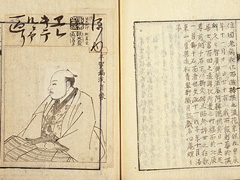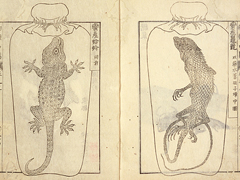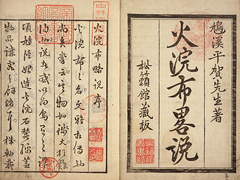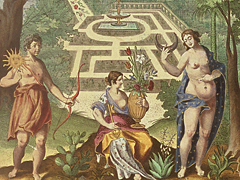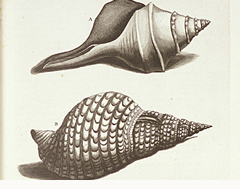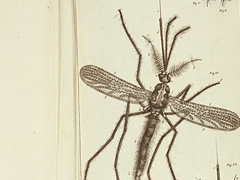Home | Part 1: Tracing the History | Columns
Part 1: Tracing the History
Column
Column: Hiraga Gennai and Dutch Studies
Hiraga Gennai (1728-79) is representative of one of the ways people learned Dutch studies at the time. He was multitalented and was also an entrepreneur and popular writer among other pursuits, and his aim was to broadly contribute to society through the adoption of Western science and technology, and so he held the medical and pharmaceutical trade shows and also worked on producing fire-resistant blankets and the Elekiter (a static electricity generator). Although he could understand almost no Dutch, he collected the natural history works of R. Dodoens, J. Jonston and others, and also met with the chiefs of the Dutch factory during their stay in Edo on court journey. His work was not understood by the people of the time, however, and his lifestyle gradually declined until one day he accidentally killed someone, and he died in prison. His friend, Sugita Genpaku, noted his death with regret saying, "He was an exceptional person."
Portrait of Hiraga Gennai
Sentetsu zoden.
Edited by Hara Yoshitane. Ms. 7 v. <か-74>
|
This book is a collection of portraits and biographical sketches of famous people. The portrait of Gennai (contained in Volume 4: Shirin bu) is a drawing showing him a little plump and differs from the generally known slim body of him, but it is written in the margin of the page that this portrait was originally drawn by Katsuragawa Gecchi (Morishima Churyo or Katsuragawa Hoshu), so it is thought to be the more accurate representation. |
Record of the trade show held by Gennai
Butsurui hinshitsu.
Edited by Hiraga Gennai. Osaka: Kashiwabaraya Seiemon, etc., 1763. 6 v. <特1-4>
|
This book classifies and introduces the articles displayed at the trade show held by Gennai in cooperation with his teacher Tamura Ransui (Genyu). The Dutch names of Chinese medicine, such as 'slangesteen', 'kaaiman', 'hagedis', etc. are included. Volume 5 contains 36 illustrations drawn by Kusumoto Sekkei (So Shiseki). |
Commentary on the blanket made of asbestos by Gennai
Kakanpu ryakusetsu.
By Hiraga Gennai. Osaka: Kashiwabaraya Seiemon, etc., 1765. 1 v. <特1-3434>
|
This book introduces the Kakanfu, a fire-resistant blanket (blanket made of asbestos) successfully fabricated by Gennai. The blanket is explained with illustrations based on knowledge taken from Chinese books, Dutchmen, and Dutch books. Morishima Churyo's Komo zatsuwa also mentions the fire-resistant blanket fabricated by Gennai. Belonged to the Shirai Collection (Japanese). |
Komo kafu collected by Gennai
Sweerts, E.: Florilegium amplissimum et selectissimum.
Amstelodami: J. Janssonium, 1647-54. 2 pts. in 1 v. <WB32-2(41)>
|
This is a catalog of 560 different garden plants, and consists of 110 hand-colored copper engravings. The first edition was published in Frankfurt in 1612-15. It was also published in Amsterdam in 1620. What was obtained by Gennai in 1761 and called Komo kafu by him was an earlier edition published in 1631. |
Komo kaifu collected by Gennai
Rumpf, G. E.: D'Amboinsche rariteitkamer.
Amsterdam: F. Halma, 1705. 1 v. <WB31-21>
|
This book introduces a study of marine organisms of Ambon Island (currently a part of Indonesia) together with 60 copper engraved plates. Gennai obtained the 1705 edition, which he called Komo kaifu. |
Komo chufu collected by Gennai
Swammerdam, J.: Biblia naturae, sive Historia insectorum.
Leydae: I. Severinum, etc., 1737-38. 2 v. <YP19-327>
|
This edition contains the contents of Historia insectorum generalis published in 1669 that Gennai obtained and called Komo chufu. The end of Volume 2 shows illustrations of observations of mosquitoes and other insects under a microscope, and these were copied by Shiba Kokan and carried in Komo zatsuwa and were also used in Kusazoshi (illustrated storybooks). |
Copyright © 2009 National Diet Library. Japan. All Rights Reserved

